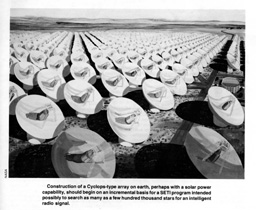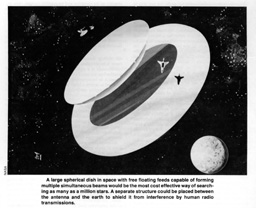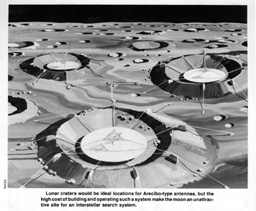 During 1975 and 1976, several of us at SRI (then known as the Stanford Research Institute) did a study for the SETI Program Office at the National Aeronautics and Space Administration (NASA) to find out what kind of antenna system would be best suited to searching for a radio signal from outer space. We developed a methodology that allowed us to compare such different concepts as antennas on earth, in space, and on the moon, and we found that space systems are the best if we need to examine more than a few hundred thousand stars in our search for an intelligent signal.
During 1975 and 1976, several of us at SRI (then known as the Stanford Research Institute) did a study for the SETI Program Office at the National Aeronautics and Space Administration (NASA) to find out what kind of antenna system would be best suited to searching for a radio signal from outer space. We developed a methodology that allowed us to compare such different concepts as antennas on earth, in space, and on the moon, and we found that space systems are the best if we need to examine more than a few hundred thousand stars in our search for an intelligent signal.
Thanks to the pioneering work of Frank Drake, Philip Morrison, and Bernard Oliver, among others, we now have a testable hypothesis about powerful microwave signals transmitted by other civilizations in our galaxy. First, the signal is assumed to be in the wavelength band from 18 to 21 centimeters. This band is known as the "water hole" because it is bounded by the natural-line wavelengths radiated by the dissociation products of water and because it is within the portion of the spectrum with the lowest background noise for an electromagnetic detection system. Second, it is assumed that the signal is being transmitted in our direction with an effective radiated power of one gigawatt (one billion watts). This assumption about the
transmitted power is somewhat arbitrary, but it is plausible in light of the fact that we are now developing detailed designs for our own solar power satellites that will each transmit 10 gigawatts of microwave energy toward the earth from geosynchronous orbit. Finally, it is assumed that the search should be directed toward individual stars judged likely to be associated with transmitting civilizations.
How Do We Choose a System?
The type of radio equipment we need will vary depending on the number of stars we decide to examine. The optimum system for searching hundreds or thousands of stars is quite different from one designed to search millions. In our entire galaxy, there are billions of stars that are enough like our sun to be good candidates for SETI. With our present limited resources, though, there is no point in talking about extending the search beyond our local galactic neighborhood. There are more than two million candidate stars within 1000 light-years of earth, and if we do not detect a signal from one of these, we clearly should reconsider our hypothesis.
A number of technical parameters, such as sky coverage, system temperature, antenna size and efficiency, and dwell time on a given star, must be considered in evaluating interstellar search systems. However, we can compensate for weak parameters in any system by building larger antennas. In this way, all systems can be made to achieve the same performance, as measured in such terms as detection sensitivity and probability of receiving a signal. With technical issues thus conveniently set aside, we are able to choose a system on the basis of only two considerations with which everyone is familiar: time and money.
Although time is in some ways related to money, it requires individual attention here because all of us, being mortal, are to some degree impatient. We want our answer soon, and the prospect of not receiving a signal in our lifetime can drastically dampen our enthusiasm for getting a search underway now. In the hope of minimizing the search time, our approach should be to start examining the individual candidate stars that are closest to earth, and then to extend the search to include stars at greater and greater ranges. If we were to spend only half an hour searching each star, which is a practical value for the
search or dwell period, it would take about 57 years to examine a million stars one by one. If we are limited to looking at one star at a time, and if we are unfortunate enough to have to examine millions of stars before we receive a signal, the search will thus require a century or more. Thus, for large-scale searches, a premium is placed on the ability to operate with several simultaneous antenna beams, each directed toward a different star. Of course, we could change our assumption about the effective radiated power of the transmitted signal and use a low-gain antenna with broad enough beam to include several stars simultaneously. However, this low-gain approach transfers a much heavier burden to the transmitting civilization; so for purposes of this discussion, let's stick with the strategy of searching individual stars instead of patches of sky.
With regard to money, there are various ways of discussing the cost of a system. We could talk simply in terms of the procurement cost, which is what we have to pay for the equipment itself, but some systems that are cheap to buy are expensive to operate and maintain. Also, some exotic systems might be cheap to buy, operate, and maintain, but they require a tremendous investment in research and development before they can be made available. For these reasons, I compare different system concepts on the basis of overall cost, defined as the sum of the costs for research and development, procurement, and operation and maintenance for the duration of the time required to search a given number of stars. By applying the basic methodology of adjusting antenna size until all systems achieve the same level of performance, we can use considerations of time and money to show how such far-out concepts as interstellar search systems on the moon or in space compare with more
conventional systems on earth.
Earth-based Systems
 There are only two viable alternatives for an interstellar search system on earth. One is an array of fully-steerable
parabolic dishes such as that described in the Cyclops study conducted by NASA in the summer of 1971. The other is an
array of fixed spherical dishes similar to the one in operation near Arecibo, Puerto Rico, in a natural sinkhole in the
Karst topography of that region. A 305-meter Arecibo dish, compared to a 100-meter Cyclops dish, costs less per unit
area, but covers less sky because of its more limited steering capability. When arrays of these dishes are compared
on the basis of the number of stars they can examine, it is found that they do not differ significantly in terms of overall cost. Cyclops is thus suggested as the preferred design for an earth-based SETI system because it has fewer constraints on its operation and its possible location than an Arecibo-type system.
There are only two viable alternatives for an interstellar search system on earth. One is an array of fully-steerable
parabolic dishes such as that described in the Cyclops study conducted by NASA in the summer of 1971. The other is an
array of fixed spherical dishes similar to the one in operation near Arecibo, Puerto Rico, in a natural sinkhole in the
Karst topography of that region. A 305-meter Arecibo dish, compared to a 100-meter Cyclops dish, costs less per unit
area, but covers less sky because of its more limited steering capability. When arrays of these dishes are compared
on the basis of the number of stars they can examine, it is found that they do not differ significantly in terms of overall cost. Cyclops is thus suggested as the preferred design for an earth-based SETI system because it has fewer constraints on its operation and its possible location than an Arecibo-type system.
One possible way of reducing the costs of an earth-based SETI program would be to modify the dishes so they can be used as solar collectors during the day and to sell the electrical power they produce. Although the details have not been worked out, preliminary estimates indicate that a system with this dual function may be both technically feasible and economically attractive.
Space Systems
 An orbiting antenna system has several attractive features. It has complete sky coverage, it can track a given star continuously if a signal is detected, and the weightless, weatherless environment in space gives it long life and allows it to be structurally simple. In addition, the time required to search a large number of stars can be substantially reduced by using multiple free-floating feed systems with a single primary receiving dish to form several simultaneous beams.
An orbiting antenna system has several attractive features. It has complete sky coverage, it can track a given star continuously if a signal is detected, and the weightless, weatherless environment in space gives it long life and allows it to be structurally simple. In addition, the time required to search a large number of stars can be substantially reduced by using multiple free-floating feed systems with a single primary receiving dish to form several simultaneous beams.
Another possible advantage of a space system is its freedom from interference produced by human radio transmissions. It may be possible for an earth-based system to avoid this interference problem through appropriate international agreements to keep the water hole quiet, but a space system could provide its own protection in the form of a separate structure to shield it from the earth.
Although there are many uncertainties in estimating the costs of space antennas, it seems clear that small space-systems will be more expensive than comparable systems on earth. However, very large systems designed to search more than a few hundred thousand stars will probably be cheaper if located in space. In other words, if we ever do decide to undertake a really large-scale search, we could save substantial amounts of both time and money by using a large space antenna with multiple beams. Of course, lots of research and development effort will be needed before we will have the capability to deploy a large SETI antenna in space, but this effort would be a straightforward extension of the programs that several aerospace companies now
have underway for the development of space antennas for terrestrial communications applications.
Moon-based Systems
 The far side of the moon is an attractive site for an interstellar search system primarily because it is always facing away from the earth and is thus completely free from radio frequency interference from transmitters either on earth or in orbit around the earth. The absence of a substantial atmosphere and the relatively weak gravitational force also provide an advantage for lunar systems because they can be much less massive than similar structures on earth. A serious disadvantage, however, is the high cost of building and operating a system on the moon.
The far side of the moon is an attractive site for an interstellar search system primarily because it is always facing away from the earth and is thus completely free from radio frequency interference from transmitters either on earth or in orbit around the earth. The absence of a substantial atmosphere and the relatively weak gravitational force also provide an advantage for lunar systems because they can be much less massive than similar structures on earth. A serious disadvantage, however, is the high cost of building and operating a system on the moon.
When antennas on the moon are compared on the basis of the number of stars they can examine, it is found that the overall cost of Arecibo-type systems on the moon is much lower than the cost of Cyclops-type systems, whereas the costs of these two different systems are virtually the same on earth. This advantage for Arecibo-type antennas on the moon results from the possibility of using lunar craters to make a significant improvement in antenna design. In particular, the towers that support the feed, which are a major component of the cost of the actual antenna in Arecibo, can be eliminated on the moon by choosing large craters and filling only a portion with the reflector. Both the feed and the dish can thus be suspended on long cables
extended from the crater rim. The abundance of lunar craters of a suitable size (about 700 meters in diameter) makes this design improvement feasible.
Nevertheless, when antennas on the moon are compared with antennas on earth or in space, even these improved lunar systems are found to be much more expensive than either of the other systems. Furthermore, the primary attraction of a moon-based system is freedom from radio frequency interference, but this freedom is also available with space systems, so there seems to be no point to giving serious consideration to the moon as a potential base for SETI activities.
An Incremental SETI Program
It is probably safe to assume that all of us who read COSMIC SEARCH would like to start right away on a substantial SETI program that can be sustained until we are satisfied that we have not overlooked any easily detectable signals from any galactic neighbors we may have. I would like to suggest that a sensible strategy for a SETI program could be based on a trade-off between systems on earth and in space. In particular, research and development efforts could begin immediately for systems both on earth and in space. If effective protection against radio frequency interference can be assured, procurement of an
earth-based system, perhaps with a solar power capability, could begin within 5 years, and it could proceed at a rate of perhaps 50 dishes per year for a maximum of about 10 to 15 years. The search could begin as soon as the first dish is operational, and each new dish could join the search when it is ready.
If the interim search has not been successful, and if preliminary prototype tests have proved the feasibility of the space system concept, the procurement of the earth-based system could stop after a few hundred dishes have been constructed. At this time, a susbstantial commitment could be made to the procurement of a large space system. The procurement period would extend over perhaps 5 to 10 years, during which time the earth-based system could continue its search. Ultimately, the entire cost of the earth-based system might be recovered from its profitable operation as a solar power plant.
Once the large space system becomes operational, its multibeam design would allow it to complete a search of all the candidate stars out to a range of 1000 light-years within a few years. Thus, before the end of the second decade of the next century, we could make a definitive test of the hypothesis that at least one civilization within our thousand-light-year neighborhood is transmitting an effective radiated power of one gigawatt in our direction in the wavelength band from 18 to 21 centimeters.
I will personally have to be pretty lucky to live long enough to see the conclusion of such an ambitious program. However, no one can calculate how long the search will have to be continued, since it is entirely possible that we could detect a signal early in the program. For this reason, I have not said anything here about what the actual overall cost of such a program might be. It is more appropriate to say that as a long-term average, the expenditures would represent only about ten percent of the present annual NASA budget.
Opportunities for Man in Space
If we want to mount a large-scale search effort, we should plan to carry it out eventually with an antenna in space in accordance with the SETI program outlined above. For many reasons, I think it is important to emphasize that a SETI program should be considered as part of our space program. Not only do we look to space as the region that may harbor other life-forms, but we can assume that any civilizations that are broadcasting a detectable beacon signal have probably developed a considerable space technology of their own, from which we might have much to learn. The most effective way for them to establish a beacon would be to put it in orbit around their star, to collect energy from the star's radiation in the visible portion of the spectrum, and to reradiate it omnidirectionally as microwaves.
Of course, if other civilizations have a space capability, we are faced with the paradox that we see no solid evidence that they have traveled to our solar system. Unless we are impeded in some way, I expect that we ourselves will eventually travel throughout the galaxy, and if we would do it, surely others would be similarly inclined. There are basically two reasons that we might undertake expeditions to other stars. One would be to explore, to find out what is there. The other would be to extend our domain to include regions of space around other suns. However, one thing that might decrease our desire for such a journey would be to learn that other civilizations are already established at our intended destinations. If they tell us about themselves in detail over high data-rate communication channels, what would then be the point of transporting matter when
information can be transmitted faster and cheaper? Here we see time and money again appearing as compelling considerations controlling our choices.
It is reasonable that we should look before we leap, but what if no one is transmitting? In fact, why should anyone ever establish a beacon? For one thing, they might want to try to attract a response that could save them time and expense of a journey, but I submit there may also be a more fundamental motivation. All intelligent creatures will share an uncertainty about what the future holds. In an attempt to preserve something of their life-form as a hedge against this uncertainty, they might broadcast a message in the hope that somewhere, sometime, it might be received and understood. In fact, we have already attached messages to spacecraft leaving our solar system, and we have transmitted a message from the Arecibo dish.
What attracts us to the search for extraterrestrial intelligence is the rare opportunity to combine technology and philosophy. The crucial philosophical point for me has been to appreciate SETI as a legitimate endeavor within the framework of the classical scientific method. The essence of the scientific method is hypothesis testing. It is used to improve our understanding of reality by comparing observations with predictions, but it also operates beyond this intellectual sphere. Life itself evolves by engaging in its own version of the scientific method, in the sense that individual organisms are specific hypotheses that are advanced by their species for testing. Abraham Lincoln recognized that the process operates even in the political sphere when he said, "We are a new nation dedicated to the proposition that all men are created equal. We are testing whether that nation can long endure."
In a sense, our SETI program is testing whether intelligent life can long endure. If we fail to find a signal, the sobering implication will be that advanced technological civilizations in our galaxy have not yet found a way to prolong their existence.
 Roy P. Basler is a specialist in the design and evaluation of large-scale systems such as the SETI systems he discusses in his article. Born in Florence, Alabama, in 1935, he received an A.B. degree from Hamilton College, Clinton, New York, in 1956, and an M.S. in geophysics in 1961 and Ph.D. in physics in 1964 from the University of Alaska. Since 1973 he has been at the Stanford Research Institute (SRI), now SRI International, Menlo Park, California 94025, where he is senior physicist in the Radio Physics Laboratory of the Systems Research and Analysis Division. He is author of numerous technical articles, many dealing with ionospheric and auroral phenomena.
Roy P. Basler is a specialist in the design and evaluation of large-scale systems such as the SETI systems he discusses in his article. Born in Florence, Alabama, in 1935, he received an A.B. degree from Hamilton College, Clinton, New York, in 1956, and an M.S. in geophysics in 1961 and Ph.D. in physics in 1964 from the University of Alaska. Since 1973 he has been at the Stanford Research Institute (SRI), now SRI International, Menlo Park, California 94025, where he is senior physicist in the Radio Physics Laboratory of the Systems Research and Analysis Division. He is author of numerous technical articles, many dealing with ionospheric and auroral phenomena.
Readers interested in more details on some of the results presented in this article may refer to Dr. Basler's article in
Radio Science, vol. 12, pages 845-858, 1977 and to NASA Contract Final Report NAS2-8938, 1976. Copies of both publications are available from the author.

![[NAAPO Logo]](../../Images/NAAPOsm.jpg)
![[NAAPO Logo]](../../Images/NAAPOsm.jpg)